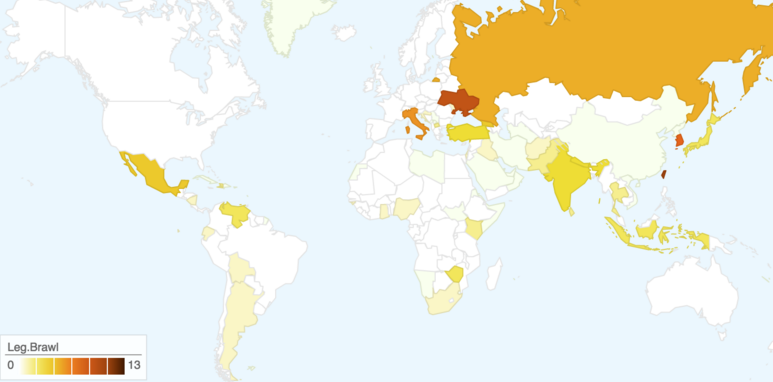What can be done to help reduce legislative violence in Ukraine? One possible improvement would be to move away from a mixed electoral system that both creates disproportionate outcomes and highlights how disproportionate these outcomes are.
Ukraine’s parliament has been the site of many large violent brawls between legislators. Most recently, a member of parliament, Oleh Barna, handed Prime Minister Arseniy Yatsenyuk a bouquet of flowers while the PM gave a speech. Barna then grabbed the PM, attempting to pull him from the podium. Other members of parliament rushed into the fight. Despite the dramatic and frequent nature of Ukraine’s parliamentary brawls, the country is not unique. Instead, I find in recently published research that violence in national legislatures is common around the world.
Figure 1. Incidents of physical fights between legislators in national legislative chambers 1981-2012 (Gandrud 2015)

Figure 1 shows brawls in national parliamentary chambers recorded in my database of legislative violence from 1981 through 2012. Ukraine clearly sticks out as a country with many brawls, but it is not alone. South Korea and Taiwan have similarly high numbers of brawls. Parliamentary scuffles have occurred in over 30 democracies between the 1980s and 2012. Violence was even present historically in now “advanced democracies”. A particularly vicious confrontation occurred in the United States Senate in 1856 when one legislator caned another close to death. What characteristics does this diverse group of countries share? How might finding these similarities help us better understand why these fights occur and how to prevent them?
First, all of the countries with violence in the database have new democracies. The oldest democratic regimes in the sample with violence are Italy and Japan. Both political regimes only emerged after World War II. The vast majority of the countries with violence have much younger democracies, often only a decade or so old. Second, virtually all of the countries have notably disproportional electoral outcomes – the votes cast in elections don’t closely correspond to the legislative seats awarded to parties.
Why would countries with new democracies and disproportionate electoral outcomes have more violence?
Much as countries often go to war because they have difficulty making credible bargaining commitments (Fearon 1995), I argue that violence in national legislatures is fundamentally about an inability of MPs to be able to credibly commit to follow peaceful legislative bargains. A credible commitment problem occurs when conflicting sides are not able to make the other side believe that it will actually stick to an agreement reached through peaceful bargaining. This makes it unlikely that either side will make a peaceful bargain to begin with.
Credible commitments are more difficult to make in countries with disproportionate electoral outcomes, because high disproportionality means that one side could have much more power than they currently do if the electoral laws were changed. This gives them a reason to fight. Commitments are harder to make in new democracies for a variety of reasons. Peaceful legislative norms, that reinforce commitments, have not had time to develop. Political party systems are typically fluid while politicians work out electoral coordination problems (see Mainwaring and Zoco, 2007; Cox 1997). New democracies frequently have rapidly shifting economies and demographics that can further destabilise party systems. New democracies are often in “new” countries, such as Taiwan and South Korea, where due to border disputes there are significant disagreements between legislators about what constitutes the boundaries of the nation and how to secure these boundaries. It may be very difficult to make credible commitments about these types of issue.
How do the general patterns apply to present day Ukraine? Ukraine is a new democracy with a rapidly shifting party system and demographics. A large part of this instability is caused by the very borders of the state changing as a result of conflicts with Russia and rebel groups in the country’s eastern regions. All of these features fit the global pattern of legislative violence.
What about electoral proportionality? This is a potentially important question when we are thinking of plausible institutional designs choices for discouraging violence. Electoral systems, for example, are relatively easy to change, whereas we can’t simply make a new democracy old.
On the face of it, Ukraine’s current parliament seems to closely reflect votes cast in the 2014 election. The 450 parliamentary seats were allocated using a mixed electoral system. Half were allocated using a national closed party-list based on proportional voting. The other half were allocated in first-past-the-post constituencies (FPTP). It’s important to note that due to the Russian annexation of Crimea and the ongoing conflict in eastern Ukraine, only 423 seats were filled.
The initial governing coalition included five parties. These parties gained about 63% of the national party-list vote and were awarded 288 seats–64%–of the 450 seats. Despite being very proportional on the surface, this result hides a considerably disproportionate outcome.
First, while the coalition’s total vote share closely resembles its share of the official 450 seats, the largely western-oriented coalition controls a disproportionate share of legislative voting power. Their 288 seats represented 68% of seats actually allocated. Furthermore, voters in Crimea and disputed eastern regions votes clearly are not included in the total votes cast. As such, the coalition parties’ vote shares and so seats are likely inflated relative to latent support among possible voters within Ukraine’s boundaries for most of the post-Soviet period.
Second, there is considerable disproportionality within the governing coalition. In particular, the party with the most seats and the presidency – Petro Poroshenko Bloc–gained just under 21% of the national party list vote. However, due to success in FPTP districts–an electoral system noted for its ability to create disproportionate outcomes–it ended up with almost 30% of the seats. Petro Poroshenko Bloc’s coalition partners fared poorly. For example, the party with the second most seats and the prime ministership–People’s Front–had the highest party list vote share at over 22%. But it only gained about 18 percent of the seats.
Third, the governing coalition is highly unstable. Recent research in VoxUkraine, for example, indicates that legislators’ actions do not closely correspond to their nominal coalition allegiance.
The mixed electoral system, combined with an unstable coalition, creates a particularly toxic situation. It gives legislators’ precise knowledge about their national support among voters, while also creating seat allocations that diverge from this support.
This is precisely a situation where we would expect politicians to find it difficult to make credible commitments and instead fight. It is not surprising that the recent parliamentary brawl between Oleh Barna and PM Arseniy Yatsenyuk was a fight between a member of Petro Poroshenko Bloc and People’s Front. While both parties are in an (unstable) governing coalition, one group has a very disproportionate level of legislative power and both parties know it.
What can be done to help reduce legislative violence in Ukraine? One possible improvement would be to move away from a mixed electoral system that both creates disproportionate outcomes and highlights how disproportionate these outcomes are. An alternative would be a more proportional electoral system, that also helps stabilise the weak party system and enable regionally proportional outcomes. An example is multi-member constituencies with closed party lists. Nonetheless, it’s important to emphasise that while electoral systems can be designed to encourage certain outcomes, they cannot ensure them. Furthermore, the causes of legislative credible commitment problems are complex and not easily fixed by any one intervention.
References
[1] Cox, Gary W & Mathew D McCubbins (2007) Legislative Leviathan: Party Government in the House. Cambridge: Cambridge University Press.
[2] Fearon, James D (1995) Rationalist explanations for war. International Organization 49(3): 379–414.
[3] Gandrud, Christopher. 2016. “Two Sword Lengths Apart: Credible Commitment Problems and Physical Violence in Democratic National Legislatures.” Journal of Peace Research: 1–17.
[4] Mainwaring, Scott & Edurne Zoco (2007) Political sequences and the stabilization of interparty competition: Electoral volatility in old and new democracies. Party Politics 13(2): 155–178.
Attention
The author doesn`t work for, consult to, own shares in or receive funding from any company or organization that would benefit from this article, and have no relevant affiliations



